NurseryAreas
From coraldigest
The Importance of Nursery Areas
What are nurseries?
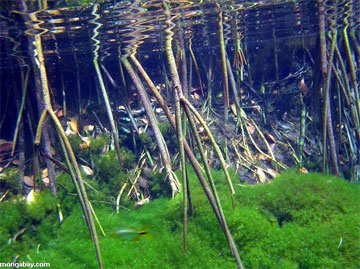
- Nurseries, by definition, are places that are naturally or unnaturally conducive to reproduction and development of species that bears more significance that a normal spawning area. These nurseries can be found in more than one habitat around the world naturally and unnaturally[1,2,8]. The “natural nurseries” are those that are found in nature, and artificial are those than many conservationists implant within nature with a goal of increasing the abundance of certain species[1,8].
- Some basic characteristics of natural nurseries include reefs that are sheltered from outside forces, such as a lagoon or mangrove forest[1]. Others are areas where the currents are slow and steady, such as a kelp forest or a seagrass bed. They are also accessible to smaller fish and to a nutrient source, making the water full of life[4]. Finally, nurseries tend to be very fragile and can be thrown out of balance by slight modifications of ocean conditions, such as estuaries. Either way, in any natural nursery, the density of youth fish is greater than the density of the adult fish[4].
- Artificial nurseries tend to be formed near other coral reefs in order to increase the chances of cross breeding and speciation[8]. They are also in areas where the water has a low turbidity to allow sunlight to reach the zooxanthallae on the coral. Finally, artificial nurseries tend to either be on the seafloor around 30-50ft deep to allow sunlight to reach them, or suspended in the water by buoys on the surface at 10-15ft deep[8]. They are located in areas that are sandy on the bottom to not infringe on other fragile ocean ecosystems[9].
What are the purpose of nurseries?
- Natural nurseries are formed through natural processes, and thus their causation is largely based off of evolution [1,2,3,4]. They protect smaller fish and aquatic life that otherwise would not be able to survive to without the support of a nursery [1,2,3,4]. This allows them to grow and develop into adults that can survive in harsher conditions.
- Artificial reefs, on the other hand, were started out of a necessity to rehabilitate coral[9]. People realized that corals were on the decline due to many factors that are either directly or indirectly caused by man. Those that knew of the importance of coral reefs and the vital part they play in many ocean ecosystems began to think of plans to restore the corals[9]. Their plan was to grow more coral in an ocean environment and then transplant various corals to different locations to allow them to regrow and the reefs to form again[9]. Although the process of rehabilitating corals to go back to the ocean where conditions were hazardous seems unnecessary and redundant, the corals that were rehabilitated were sampled from different reefs and placed near each other[9]. This allows for cross breeding and natural selection that will make those corals most fit for the current conditions the most likely to leave fertile offspring[9].
Differences between nurseries and Protected/Managed Ocean Areas
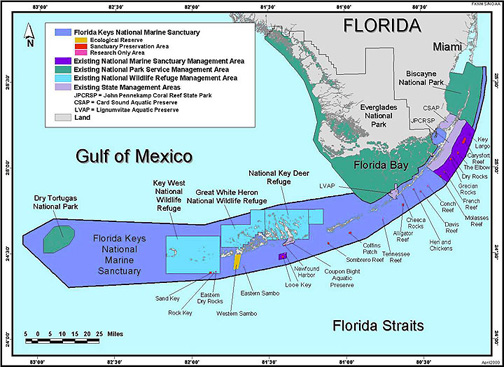
- Nurseries are vastly different from protected sea and reef areas, whether they are natural or artificial. Protected sea areas, to begin with, are often areas that are threatened or in decline[5]. They are governed into inaction by legislative action, and are enforced by government entities. They also tend to be very large because there are not environmental or geographical limits to what man can protect by legislation[5]. In contrast, some natural nurseries are thriving and not in decline. All artificial nurseries are being warranted due to threatened coral and reefs in decline. Natural nurseries are not created by a government, but rather by environmental means[7]. Thus, they tend to be much smaller than managed ocean areas. Artificial nurseries are always brought about by governmental action, even if on the local level[5,6,9]. They are also not large, but this is because it is difficult and costly to manage a large artificial nursery[9]. Finally, whereas protected or managed ocean areas are formed for the purpose of preservation, artificial nurseries are formed for the purpose of rejuvenation. They are specifically intended to regrow coral and to be utilized by scientists for a specific purpose rather than just to be protected from harmful practices. [9]
Reef Nurseries
- Reef nurseries are artificial nurseries that are formed near reefs for the specific purpose of growth of a particular reef rather than growth of coral to be transported to another location[9,10]. They are formed off the shore of larger reefs, still in typically shallow areas, and use the polyps and fragments from the “parent reef”, along with the nutrient-rich waters near the “parent reef” to grow more coral[8,9]. Furthermore, the close proximity to the “parent reef” allows for these new coral to cross breed with the original coral, combining genotypes and increasing the resiliency of the coral to changing environmental conditions[8,9]. They are typically located at a relatively shallow depth that will not be disturbed by surface human behavior but will also still receive sunlight[7,9]. These reef nurseries, however, require much attention as algae can grow uncontrollably on the coral without species such as spiny sea urchins and rainbow parrotfish to eat the coral[7,9]. Some examples of reef nurseries include the Nova Southeastern University’s Coral Nursery Initiative, which is a university-sponsored research reef nursery off the coast of the Florida Keys[8]. Other examples include the Molasses Reef restoration, which is a project that has been going on since 2004. It incorporates a reef nursery off of the Molasses Reef in the Florida Keys to then transplant the coral onto the damaged Molasses Reef[9]. In the last 10 years, the reef has seen a great deal of growth, so much that the federal government granted it $3.3 million in 2009 for further research and implementation[9]. Over the next 3 years, that money was used to start similar programs in the Dry Tortugas and in the US Virgin Islands; these combined make up the largest coral restoration program in the world[9]. These examples offer hope that such programs can bring reefs back to their past healthy state[7]. Although this may be true on a local level, even the current number of reef nurseries are not enough to bring back reefs on a global scale[7]. More must be implemented near reefs on every continent to truly maximize their potential and begin the rebuilding process of global coral reefs.
CRF-Coral Restoration Foundation
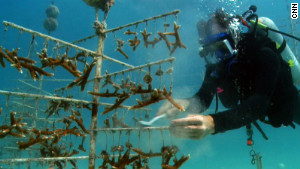
- The Coral Restoration Foundation “is a non profit conservation organization dedicated to creating off-shore nurseries,” among other things [5]. This foundation is one of the few out there that are actively doing something to make a difference. They have charter trips for students and other volunteers to plant coral and maintain nurseries offering a real-world way to impact reefs, are tax-deductible and come up with new methods/implement the newest method in the field[5]. They are largely active in the Florida Keys, but were responsible for starting the largest coral restoration project to date[9].
Mangrove Nurseries
- Mangrove Nurseries are the best example of natural nurseries. This is because these areas are among the most productive ecosystems in the world [3]. There are many different factors that affect fish growth and development, and mangroves provide the most conducive environment for large numbers of juvenile fish development[2]. One of the many factors that mangrove nurseries meet which makes them suitable is that they have low hanging roots of the mangrove trees which offer a natural barrier from predators; thus allowing juvenile fish to mature safely[1]. Examples of protective habitats that resemble nurseries are kelp forests and seaweed patches. These habitats provide natural protection similar to the roots in a mangrove[2]. In addition to the safety of the roots, the waters of mangroves are full of nutrients that aid in the development of the juveniles[1].
- Mangrove nurseries are very important to the maturation of many fish, but they are not very widespread[2]. Mangrove nurseries are generally found in areas that a coral reef would be; which are between 24 degrees north and 24 degrees south (in the tropical region of the world). However small the area of the world that is covered by mangrove nurseries, the annual resource estimation in USD is around 364 billion dollars[1].
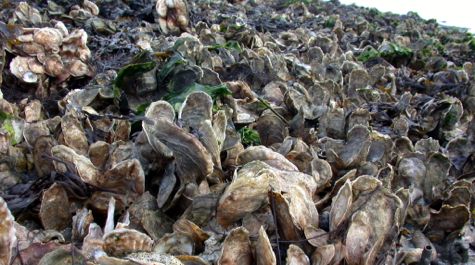
- The productivity of many mangrove nurseries to coral reefs is crucial to understanding the importance of the contribution that they offer. This can be done by collecting small tissue samples from a fish in a nearby coral reef and analyzing the chemical compositions of them. Then, the compositions of the coral reef fish are compared to that of the fish in various nurseries in order to determine the coral reef fish’s nursery that it developed in [1].
Coastal North Carolina
- It is standard to think of tropical regions of the world as the only place where a nursery can thrive. This, however, is not the case. Along the coast of North Carolina is an interesting case of a nursery, which can be found in many areas along coastlines for different fish and creatures[4]. These nurseries are areas in which creatures like oysters and fish like grouper and snapper thrive and reproduce in large numbers[4]. These creatures and fish reproduce in such high numbers in coastal estuarine ecosystems like that of the North Carolina coast line that they make up 64% of United States commercial landings (the amount of fish/shellfish captured) [4]. These coastal estuarial nurseries are just another example of nurseries that can be found across the world.
Seagrass Beds
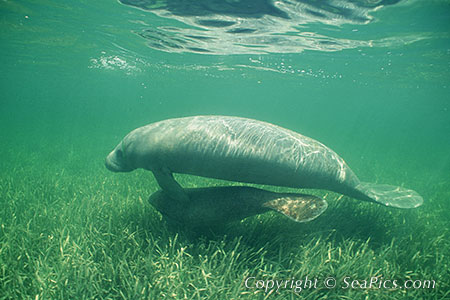
- Seagrass beds are another common type of natural nursery. Although they have less diversity than a mangrove nursery, they are teeming with nutrients from all of the dead plant matter in the water[4,7]. The shallow areas that seagrass beds form in are great protection from predators, and the seagrass offers a sheltered habitat for juvenile fish. The function of the seagrass, in this sense, can be compared to that of the mangrove roots in a mangrove nursery[1]. In addition, the seagrass beds are more congested with vegetation and can even trap small particles of food for juvenile species. These seagrass beds can be found in the open ocean, such as the rotating kelp patch in the Sargasso Sea, or close to shore[7]. They are also found in temperate and tropical zones as the different seagrass species grow best in different temperatures. This makes them a very widespread nursery area.
Minor Nursery areas
- Other minor nursery areas can include oyster or rock nurseries that can exist where rock formations or oyster beds offer protection from other species and the open ocean[6]. Finally, seamounts can act as nursery areas in the open ocean. The shallow water and plant life that forms on them can offer protection from deep-sea predators[7].
Current situation
- There are two main ways to protect and grow nurseries. The first is to issue governmental protection of nursery areas. This is a common practice for natural nurseries. In this form, governments are expanding normal protected/managed areas to cover the fragile nurseries[[5]. This is occurring in the Northwestern Hawaiian Islands thanks to a task force of government officials and native elders there that lobbied for changes in Washington, DC[5]. In addition, similar steps are being taken in the Great Barrier Reef. Although protective measures already exist in the most pristine parts of the reef, zoning regulations are being enacted that restrict the usage of waters for certain purposes like shipping, fishing, and preservation[6]. They are also enacting stricter laws on overfishing[6].
- The second way is to ensure the health of the artificial nurseries that are currently being used and developed to expand reefs. In Florida, for example, the runoff from farming and poor irrigation in the Everglades has caused record algal blooms on the Gulf side of the Florida Keys[5]. In addition to polluting the water on that side of the Keys, the polluted water has drifted out past the keys and towards the Atlantic, passing right through the nurseries that are found off of Marathon Key, Molasses Reef, Key Largo, and the Dry Tortugas[9]. Although fishermen, divers, and local inhabitants first noticed dead species of sea turtles and poor water quality on the Gulf side, they soon realized that this would also affect the artificial nurseries as well[5]. So, they formed the Florida Keys Water Quality Joint Action Group to express their concerns on a state and national level[5]. Similar organizations can be formed in other areas that may experience similar hindrances to artificial nursery success.
References
- McMahon K. 2007. One Man’s Swamp is a Fishes’ Nursery. Cayman Islands: Woods Hole Oceanographic Institute.
- Beck MW, L K, Able KW, Childers DL. 2001. The identification, conservation, and management of estuarine and marine nurseries for fish and invertebrates. Oxford: Oxford University Press, UK
- Martinho F, Cabral HN, Azeiteiro UM, Pardal MA. 2012. Estuarine nurseries for marine fish. Bradford, United Kingdom: Emerald Group Publishing, Limited.
- Fodrie, J. F. (2012). Quantifying the nursery role of SAV, oyster reef and wetland landscapes for recreationally important fishes in high-salinity environments of North Carolina. North Carolina, United States: NC Division of Marine Fisheries.
- Fujita R. 2003. Chapter 4: Coral Reefs: The Ocean’s Sensitive Child In: Heal the Ocean, Solutions for Saving Our Seas. New Society Publishers. p. 66–97.
- Lawrence D, Kenchington R, Woodley S. 2002. The Great Barrier Reef, Finding the Right Balance. Melbourne, Australia: Melbourne University Press.
- Vance, Erik . 2011. Can Coral Nurseries Bring Reefs Back From the Brink?. Scientific American [Internet]. [2011 Oct 14, cited 2014 Feb 24] . Available from: http://www.scientificamerican.com/article/coral-nurseries-bring-reefs-back-from-brink/
- The Coral Nursery Initiative [Internet]. Hollywood(CA):NSU Oceanographic Center; cited 2014 Feb 24] . Available from: http://www.nova.edu/ocean/coralnursery
- Jenkins M. 2010. A series of underwater laboratories is reviving ravaged reefs from Miami to the Virgin Islands.. The Nature Conservancy magazine (Autumn) [Internet]. [2010, cited 2014 Feb 24] Available from: http://www.nature.org/newsfeatures/magazine/pastissues/autumn-2010-the-coral-nursery.xml